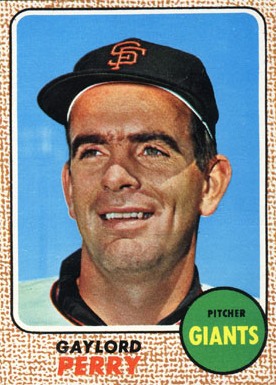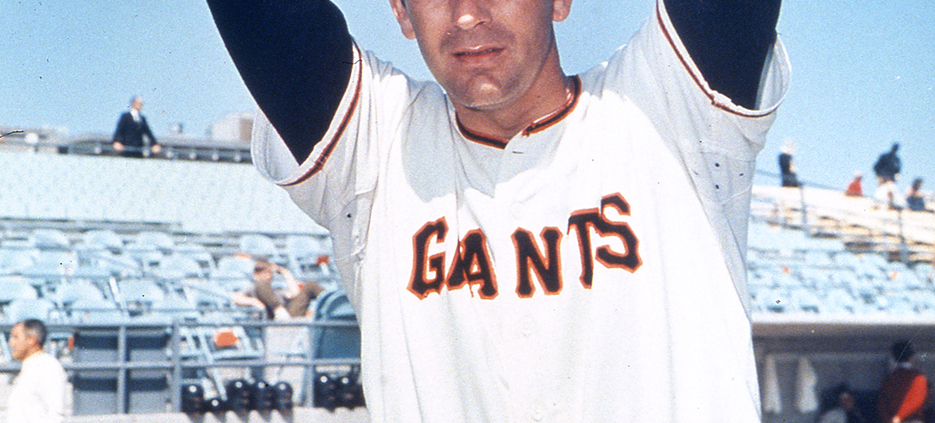September 17, 1968: Gaylord Perry no-hits Cardinals, outduels Bob Gibson

 produced that season were quite staggering. On the top of the list, Detroit’s Denny McLain won 31 games, and remains the last pitcher to win 30 or more games in a season. Luis Tiant of Cleveland led the AL in ERA with a sparkling mark of 1.60. The average ERA in the majors for 1968 was 2.98.
produced that season were quite staggering. On the top of the list, Detroit’s Denny McLain won 31 games, and remains the last pitcher to win 30 or more games in a season. Luis Tiant of Cleveland led the AL in ERA with a sparkling mark of 1.60. The average ERA in the majors for 1968 was 2.98.
San Francisco’s Juan Marichal posted a 26-9 record with a 2.43 ERA. However, he did not receive a single vote in the NL Cy Young Award balloting. The reason is that St. Louis’s Bob Gibson trumped him with a 22-9 record and an atom-like 1.12 ERA. Gibson led the Cardinals staff to an incredible team ERA of 2.49. The pitching staffs in Cleveland and Baltimore tied for the honors in the AL with team ERAs of 2.66.
The numbers go on and on in detailing how the pitchers dominated the game in 1968. One reason for this dominance was the pitching mound being raised to 15 inches. “I remember 1968, it felt like every pitcher was right on top of you that year,” said Ken Harrelson. “It felt like they weren’t 60 feet 6 inches away. It felt like they were 40 feet away.“1
Boston’s Carl Yastrzemski led the AL with a .301 batting average. He was the only hitter in the junior circuit to surpass the .300 mark (those batters who had enough at bats to qualify for the batting crown). Conversely, five batters topped the .300 mark in the National League.
“Those pitchers that year were awesome, they were something to behold,” said Harrelson. “All you have to know about that year is that Denny McLain won 31 games, and he wasn’t the best pitcher in the league. Looie Tiant was. He had a 1.60 ERA. That’s still the best ERA in the history of the league. We knew every pitch that Tiant was going to throw — we read pitchers back then — and still couldn’t hit him. Sam McDowell was on Tiant’s team. Sam had the best four pitches of anyone I’ve ever seen.”2
On September 17, 1968, it seemed only fitting that in the Year of the Pitcher there should be a matchup of two of the game’s best. The St. Louis Cardinals descended upon the City by the Bay for a three-game set against the San Francisco Giants. The pitching matchup had the makings of a dandy: Bob Gibson for the visitors and Gaylord Perry for the Giants.
The Cards had clinched the NL pennant two days earlier in Houston. The Redbirds had won their first three games in September, but were now on a 4-7 run as they appeared to be sleepwalking to the end of the season. The Giants could only look toward next spring and a new format of two divisions that would accommodate the growing landscape of major-league baseball. The term “pennant chase” would be replaced with “division race.”
Gibson entered the game with a 21-7 record and a 1.13 ERA. Gibson won 15 games in a row from June 2 to August 19. He lowered his ERA from 1.66 to 1.00. Included in that stretch were 48⅔ scoreless innings from June 2 to July 1.
Perry entered the game with a 14-14 mark and a 2.55 ERA. He had won 21 games in 1966, but turned in a 15-17 record in 1967. He still pitched well; his ERA was 2.61 in 1967.
The promise of a wonderful pitching matchup did not send the fans rushing to Candlestick Park. Only 9,546 patrons made their way to the ballpark for the late-season ballgame.
Perry set St. Louis down in order in the top of the first inning. With one away in the bottom of the frame, Ron Hunt stepped into the batter’s box. The Giants third baseman sent Gibson’s offering to the seats in left field for his second home run of the season. The Giants led, 1-0.
That was the end of the offensive output for the evening. Perry was fantastic as he allowed only two walks, one in the second and one in the eighth inning. Both free passes came with two outs. He struck out nine. The Cardinals were able to hit only two balls to the outfield. Their best chance at getting a man on base came in the top of the sixth inning. Dal Maxvill sent a shot to the left of Perry, who gloved it and threw out the shortstop. Gibson flied out to center field for the second out. Bob Tolan sent a groundball to the left of first base. Willie McCovey moved to his right and made a nice scoop and led Perry perfectly as the pitcher raced to first base ahead of the baserunner. Perry tipped his cap to McCovey “for making that tremendous play to his right on Bob Tolan’s well-hit grounder.”3
“The best thing I had going was my control,“ said Perry. “I was hitting the corners consistently and I was keeping the ball down. The hard slider was my best pitch.”4
The no-hitter was the first of Perry’s professional career. He had come close a month earlier. He allowed a hit to Glenn Beckert in the seventh inning in a 3-0 win over Chicago on August 26. “When I got into the seventh inning against the Cardinals, I couldn’t help thinking of Beckert,” said Perry. “Nobody on our club mentioned it, but it sure was on my mind.”5 The game was played at a sprinter’s pace of 1 hour 40 minutes.
It was the first no-hitter against St. Louis since Don Cardwell turned the trick on May 15, 1960, at Wrigley Field.6
Gibson was no slouch. After surrendering the run to Hunt, he bore down, as one would expect. He struck out 10 and walked two, scattering four hits.
The Cardinals turned the tables the very next evening. Ray Washburn no-hit the Giants, a 2-0 Cardinals win. It was the first time in the major leagues that no-hitters had been pitched in successive games. On May 5, 1917, Ernie Koob of the St. Louis Browns no-hit the Chicago White Sox, and the next day Koob’s teammate Bob Groom also hurled a no-hitter against the White Sox. But it was the second game of a doubleheader.
The Cardinals met the Detroit Tigers in the 1968 World Series, losing in seven games. Gibson won two games while Washburn won the third. But St. Louis could not solve Mickey Lolich. The left-handed hurler went 3-0 in the series.
Sources
The author accessed Baseball-Reference.com for box scores/play-by-play information (baseball-reference.com/boxes/SFN/SFN196809170.shtml) and other data, as well as Retrosheet (retrosheet.org/boxesetc/1968/B09170SFN1968.htm).
Notes
1 Tim Kurkjian, “Recalling the Real Pitcher of the Year,” espn.com/mlb/columns/story?columnist=kurkjian_tim&id=6534824, May 17, 2011. Accessed March 6, 2018.
2 Ibid.
3 Neal Russo, “Perry Cuts Short Cardinal Celebration,” St. Louis Post-Dispatch, September 18, 1968: 39.
4 Ibid.
5 Harry Jupiter, “Gaylord, Ray Play No-Hit Tit for Tat,” The Sporting News, October 11, 1968.
6 Russo, “Perry Cuts Short Cardinal Celebration”: 39.
Additional Stats
San Francisco Giants 1
St. Louis Cardinals 0
Candlestick Park
San Francisco, CA
Box Score + PBP:
Corrections? Additions?
If you can help us improve this game story, contact us.


